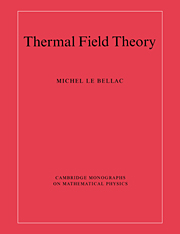Book contents
- Frontmatter
- Contents
- Preface
- 1 Introduction
- 2 Quantum statistical mechanics
- 3 The scalar field at finite temperature
- 4 Simple applications of perturbation theory
- 5 Dirac and gauge fields at finite temperature
- 6 Collective excitations in a plasma
- 7 Hard thermal loops and resummation
- 8 Dynamical screening
- 9 Neutrino emission from stars
- 10 Infrared problems at finite temperature
- A Formulary
- B Operator formalism
- References
- Index
10 - Infrared problems at finite temperature
Published online by Cambridge University Press: 05 May 2010
- Frontmatter
- Contents
- Preface
- 1 Introduction
- 2 Quantum statistical mechanics
- 3 The scalar field at finite temperature
- 4 Simple applications of perturbation theory
- 5 Dirac and gauge fields at finite temperature
- 6 Collective excitations in a plasma
- 7 Hard thermal loops and resummation
- 8 Dynamical screening
- 9 Neutrino emission from stars
- 10 Infrared problems at finite temperature
- A Formulary
- B Operator formalism
- References
- Index
Summary
This chapter deals with some infrared problems which arise in gauge theories at finite temperature. Most of these problems are still open, and represent interesting – and difficult – challenges for future investigations.
At zero temperature, the existence of singularities in field theories with massless particles has been known for a long time. It is convenient to classify these singularities into infrared and mass singularities. In order to be definite, let us take QCD as an example.
(i) A quark can emit a soft gluon, whose momentum k → 0: because the gluon is massless, this leads to infrared singularities, even when the quark is massive.
(ii) A massless quark can emit a gluon whose momentum makes a small angle θ with the initial quark momentum. The region θ → 0 leads to mass (or collinear) singularities, even if the gluon momentum k remains finite.
In both cases, the singularities arise from the fact that the final state quark + gluon is degenerate with the initial one when k → 0 in case (i) and when θ → 0 in case (ii).
Much is known about these infrared and mass singularities at T = 0; the most important information is contained in the Bloch–Nordsieck and Kinoshita–Lee–Nauenberg (KLN) theorems, which allow, in well-defined situations, control of these singularities.
- Type
- Chapter
- Information
- Thermal Field Theory , pp. 222 - 238Publisher: Cambridge University PressPrint publication year: 1996

